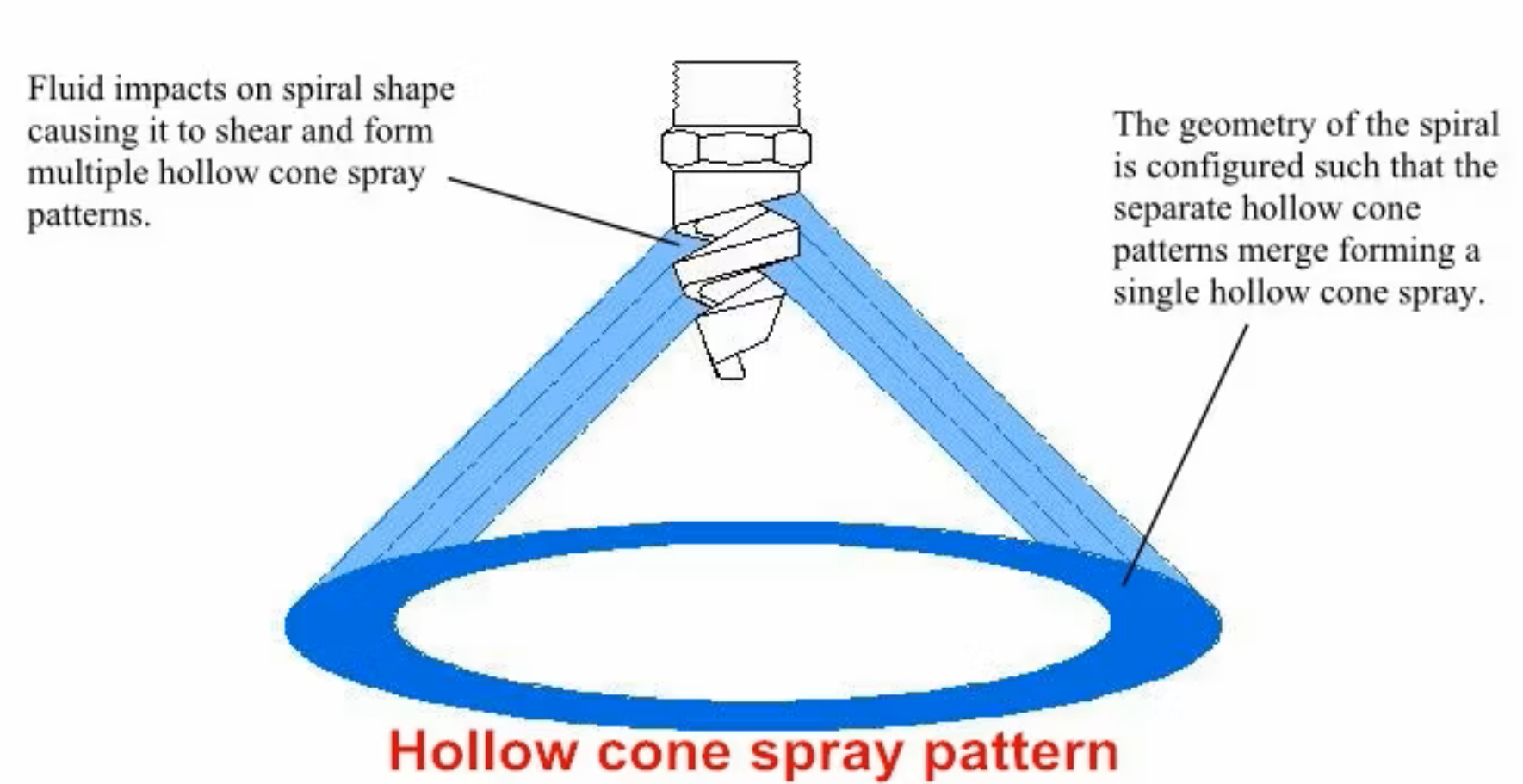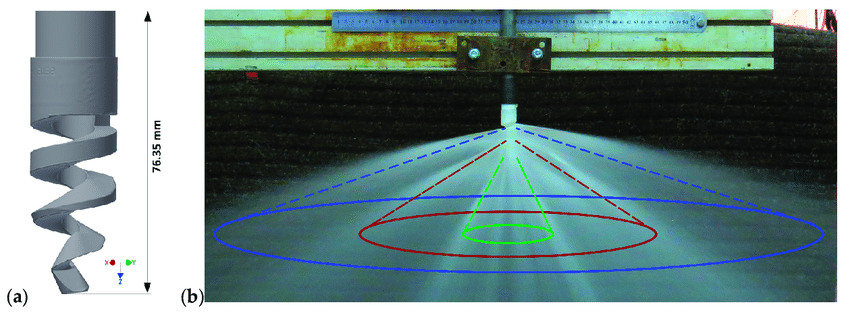
Spiral Nozzle
Spiral nozzles are a type of spray nozzle that utilize a unique internal design to create a specific spray pattern. Here's a breakdown of their working principle:
Internal Structure:
Spiral Channel: The key element is a spiral channel within the nozzle. This channel forces the fluid to flow in a helical path as it exits the nozzle.
Impact Dispersion: As the fluid travels through the spiral channel, it gains momentum and is directed towards the outer edge of the nozzle. This impact against the inner surface of the nozzle breaks the fluid into droplets.
Spray Pattern Formation:
Concentric Cones: The droplets, propelled outward by the spiral motion, form a series of concentric cones. This creates a distinctive spray pattern that can be either a hollow cone or a full cone, depending on the nozzle design.
Droplet Size: The size of the droplets can vary depending on factors like fluid viscosity, flow rate, and nozzle design. Generally, spiral nozzles produce medium to large droplets.
Applications:
Spiral nozzles find applications in various industries due to their specific spray characteristics:
Industrial Cleaning: Removing stubborn debris, coatings, or residues from surfaces.
Material Cutting: Shaping or trimming soft materials like foam or fabric.
Surface Treatment: Applying coatings, lubricants, or other substances evenly.
Agricultural Applications: Precisely directing water or chemicals onto crops.
Fire Suppression: Some spiral nozzles are designed for fire suppression systems.
Key Advantages:
Clog Resistance: The spiral design minimizes the risk of clogging, making them suitable for fluids with suspended particles.
Even Distribution: The concentric cone spray pattern ensures relatively even distribution of the sprayed material.
Versatility: They can be used with a wide range of fluids and pressures.
By understanding the unique design and working principle of spiral nozzles, you can select the appropriate nozzle for your specific application and achieve optimal results.
Spiral Nozzle: A Comprehensive Guide
1. Operating Principle
A spiral nozzle disperses a fluid in a helical or spiral pattern, creating a wide spray coverage. This design ensures a more uniform distribution of the fluid, making it ideal for applications requiring even coverage such as cooling, washing, and spray drying. The spiral flow pattern atomizes the fluid into smaller droplets, enhancing surface coverage and efficiency.

Hollow Cone Spray pattern*

Full Cone Spray Pattern*
2. General Technical Specifications
| Feature | Values |
| Nozzle Type | Spiral Nozzle |
| Droplet Size |
20 - 150 microns (varies based on nozzle type, pressure, and fluid)
|
| Operating Pressure |
2 bar – 50 bar (varies based on model and application)
|
| Flow Rate |
0.5 L/min – 500 L/min (adjustable based on application)
|
| Spray Pattern |
Spiral (helical pattern)
|
| Spray Angle |
30° - 170° (commonly 60° - 90°)
|
| Fluid Type |
Water, water-based mixtures, chemicals, oils
|
| Outlet Velocity |
3 m/s – 25 m/s (depends on nozzle type and fluid properties)
|
| Material Selection |
Stainless steel (SS 304, SS 316), PVC, PVDF, PTFE, etc.
|
| Connection Type |
Threaded, flange, industrial connections
|
| Operating Temperature |
-10°C to 150°C (depends on material and fluid)
|
| Corrosion Resistance |
High (especially stainless steel and plastic models)
|
| Applications |
Cooling systems, cleaning, spray drying, chemical distribution, surface treatment
|
3. Sizing and Performance
Flow Rate Calculation:
The flow rate of a spiral nozzle is typically calculated based on operating pressure and fluid properties. The following formula can be used:
Q = C_d * A * √(2 * ΔP / ρ)
Where:
Q = Flow rate (L/s or m³/s)
C_d = Discharge coefficient (varies based on nozzle type and size, typically 0.8 - 0.95)
A = Nozzle outlet area (m²)
ΔP = Pressure difference (bar or Pascal)
ρ = Density of the fluid (kg/m³)
Droplet Size:
Droplet size for spiral nozzles is usually between 20-150 microns. Higher pressure results in smaller droplets and a more efficient spray.
Spray Angle:
Spray angles for spiral nozzles typically range from 30° to 170°, with 60° to 90° being more common. This angle determines the spray coverage.
Outlet Velocity:
Outlet velocity depends on the applied pressure and fluid properties, ranging from 3 m/s to 25 m/s.
4. Advantages
Uniform Distribution: Provides even distribution of fluid over a wide area.
High Efficiency: Ensures efficient cooling or cleaning due to wider coverage.
Energy Efficient: Achieves high performance with lower energy consumption.
Versatility: Suitable for various fluids and applications.
Low Maintenance: Simple design with few moving parts.
5. Applications
Cooling Systems: For efficient cooling in industrial cooling towers.
Cleaning and Washing: Used in car washes, industrial cleaning, and surface treatment.
Spray Drying: For rapid drying of liquids in food, pharmaceutical, and chemical industries.
Chemical Distribution: For even distribution of chemicals.
Surface Treatment: For treating metal, plastic, and other surfaces.
6. Material Selection and Durability
Common materials include:
Stainless Steel (SS 304, SS 316): Resistant to high temperatures, pressure, and corrosion.
PVC, PVDF, PTFE: Chemically resistant and lightweight.
Brass: Less expensive but more susceptible to corrosion.
Absolutely! Here's the English translation for the provided text:
7. Sizing and Selection
Proper sizing of spiral nozzles is crucial for optimal performance. The sizing process involves considering the following parameters:
Flow Rate Requirement: Determine the required liquid volume (L/min or L/h). This depends on the material, process speed, and coverage area. Flow rate is calculated based on factors such as cooling time or cleaning efficiency.
Pressure: The correct pressure is essential for effective nozzle operation. Pressure atomizes the liquid into droplets. Lower pressure results in larger droplets, while higher pressure produces finer droplets and more uniform distribution. Pressure typically ranges from 2 to 50 bar.
Spray Pattern: The desired spray width and uniformity are also selection criteria. The nozzle's outlet angle and design determine whether the fluid is spread over a wide or narrow area. For wider coverage, angles between 60° and 90° are common, but specific applications may require narrower or wider angles.
Fluid Properties: The characteristics of the fluid, such as viscosity, density, and chemical composition, affect nozzle performance. Viscous fluids require higher pressure, while more fluid liquids can be efficiently sprayed at lower pressures.
Outlet Velocity: The fluid's exit velocity influences the uniformity of distribution. Higher velocity produces finer and more uniform droplets for wider coverage. Velocity typically ranges from 3 to 25 m/s.
Material Selection: The nozzle material should be chosen based on application conditions. Corrosion-resistant stainless steel (SS 304, SS 316), chemically resistant PVC or PTFE, offer long-lasting and reliable performance.
Selecting the right spiral nozzle involves careful consideration of all these parameters. This ensures optimal system performance, energy efficiency, and achievement of desired results.
spiral nozzle











